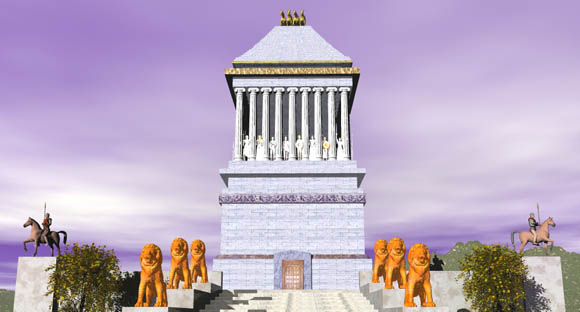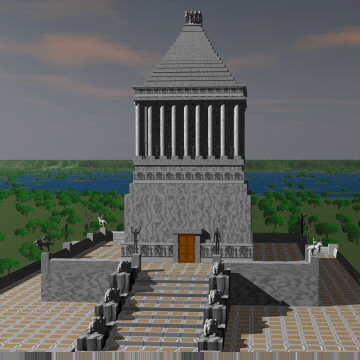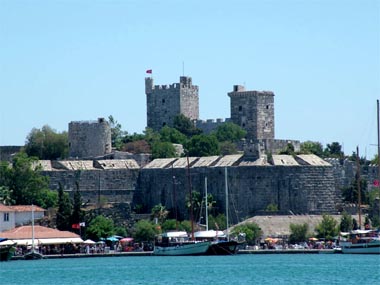pop up description layer
HOME
Cryptozoology UFO Mysteries Aviation Space & Time Dinosaurs Geology Archaeology Exploration 7 Wonders Surprising Science Troubled History Library Laboratory Attic Theater Store Index/Site Map Cyclorama
Search the Site: |
|
In 377 B.C., the city of Halicarnassus was the capitol of a small kingdom along the Mediterranean coast of Asia Minor. It was in that year the ruler of this land, Hecatomnus of Mylasa, died and left control of the kingdom to his son, Mausolus. Hecatomnus, a local satrap to the Persians, had been ambitious and had taken control of several of the neighboring cities and districts. Then Mausolus during his reign extended the territory even further so that it eventually included most of southwestern Asia Minor. Mausolus, with his queen Artemisia, ruled over Halicarnassus and the surrounding territory for 24 years. Though he was descended from the local people, Mausolus spoke Greek and admired the Greek way of life and government. He founded many cities of Greek design along the coast and encouraged Greek democratic traditions. Mausolus's Death
Then in 353 B.C. Mausolus died, leaving his queen Artemisia, who was also his sister, broken-hearted (It was the custom in Caria for rulers to marry their own sisters). As a tribute to him, she decided to build him the most splendid tomb in the known world. It became a structure so famous that Mausolus's name is now associated with all stately tombs throughout the world through the word mausoleum. The building, rich with statuary and carvings in relief, was so beautiful and unique it became one of the Seven Wonders of the Ancient World. Artemisia decided that no expense was to be spared in the building of the tomb. She sent messengers to Greece to find the most talented artists of the time. These included architects Satyros and Pytheos who designed the overall shape of the tomb. Other famous sculptors invited to contribute to the project were Bryaxis, Leochares, Timotheus and Scopas of Paros (who was responsible for rebuilding the Temple of Artemis at Ephesus, another of the wonders). According to the historian Pliny Bryaxis, Leochares, Timotheus and Scopas each took one side of the tomb to decorate. Joining these sculptors were also hundreds of other workmen and craftsmen. Together they finished the building in the styles of three different cultures: Egyptian, Greek and Lycian. The tomb was erected on a hill overlooking the city. The whole structure sat in the center of an enclosed courtyard on a stone platform. A staircase, flanked by stone lions, led to the top of this platform. Along the outer wall of the courtyard were many statues depicting gods and goddesses. At each corner stone warriors, mounted on horseback, guarded the tomb.
At the center of the platform was the tomb itself. Made mostly of marble, the structure rose as a square, tapering block to about one-third of the Mausoleum's 140 foot height. This section was covered with relief sculpture showing action scenes from Greek myth/history. One part showed the battle of the Centaurs with the Lapiths. Another depicted Greeks in combat with the Amazons, a race of warrior women. On top of this section of the tomb thirty-six slim columns rose for another third of the height. Standing in between each column was another statue. Behind the columns was a solid block that carried the weight of the tomb's massive roof. The roof, which comprised most of the final third of the height, was in the form of a stepped pyramid with 24 levels. Perched on top was the tomb's penultimate work of sculpture craved by Pytheos: Four massive horses pulling a chariot in which images of Mausolus and Artemisia rode. The City in Crisis Soon after construction of the tomb started Artemisia found herself in a crisis. Rhodes, an island in the Aegean Sea between Greece and Asia Minor, had been conquered by Mausolus. When the Rhodians heard of his death, they rebelled and sent a fleet of ships to capture the city of Halicarnassus. Knowing that the Rhodian fleet was on the way, Artemisa hid her own ships at a secret location at the east end of the city's harbor. After troops from the Rhodian fleet disembarked to attack, Artemisia's fleet made a surprise raid, captured the Rhodian fleet, and towed it out to sea.
Artemisa put her own soldiers on the invading ships and sailed them back to Rhodes. Fooled into thinking that the returning ships were their own victorious navy, the Rhodians failed to put up a defense and the city was easily captured, quelling the rebellion. Artemisa lived for only two years after the death of her husband. Both would be buried in the yet unfinished tomb. According to Pliny, the craftsmen decided to stay and finish the work after their patron died "considering that it was at once a memorial of their own fame and of the sculptor's art." The Mausoleum overlooked the city of Halicarnassus for many centuries. It was untouched when the city fell to Alexander the Great in 334 B.C. and was still undamaged after attacks by pirates in 62 and 58 B.C.. It stood above the city ruins for some 17 centuries. Then a series of earthquakes in the 13th century shattered the columns and sent the stone chariot crashing to the ground. By 1404 A.D. only the very base of the Mausoleum was still recognizable. Destruction by the Crusaders Crusaders, who had little respect for ancient culture, occupied the city from the thirteen century onward and recycled much of the building stone into their own structures. In 1522 rumors of a Turkish invasion caused Crusaders to strengthen the castle at Halicarnassus (which was by then known as Bodrum) and some of the remaining portions of the tomb were broken up and used within the castle walls. Indeed, sections of polished marble from the tomb can still be seen there today.
At this time a party of knights entered the base of the monument and discovered the room containing a great coffin. Deciding it was too late to open it that day, the party returned the next morning to find the tomb, and any treasure it may have contained, plundered. The bodies of Mausolus and Artemisia were missing, too. The Knights claimed that Moslem villagers were responsible for the theft, but it is more likely that some of the Crusaders themselves plundered the graves. Before grounding much of the remaining sculpture of the Mausoleum into lime for plaster, the Knights removed several of the best works and mounted them in the Bodrum castle. There they stayed for three centuries. At that time the British ambassador obtained several of the statutes from the castle, which now reside in the British Museum. Remains Located by Charles Newton In 1846 the Museum sent the archaeologist Charles Thomas Newton to search for more remains of the Mausoleum. He had a difficult job. He didn't know the exact location of the tomb, and the cost of buying up all the small parcels of land in the area to look for it would have been astronomical. Instead, Newton studied the accounts of ancient writers like Pliny to obtain the approximate size and location of the memorial, then bought a plot of land in the most likely location. Digging down, Newton explored the surrounding area through tunnels he dug under the surrounding plots. He was able to locate some walls, a staircase, and finally three of the corners of the foundation. With this knowledge, Newton was able to figure out which additional plots of land he needed to buy.
Newton then excavated the site and found sections of the reliefs that decorated the wall of the building and portions of the stepped roof. Also, a broken stone chariot wheel from the sculpture on the roof, some seven feet in diameter, was discovered. Finally, he found two statues which he believed were the ones of Mausolus and Artemisia which had stood at the pinnacle of the building. Ironically, the earthquake the toppled them to the ground saved them. They were hidden under sediment and thus avoided the fate of being pulverized into mortar for the Crusaders castle. Today these works of art stand in the Mausoleum Room at the British Museum. There the images of Mausolus and his queen forever watch over the few broken remains of the beautiful tomb she built for him. Copyright 2011 Lee Krystek. All Rights Reserved. |
|
Related Links |
|
|








